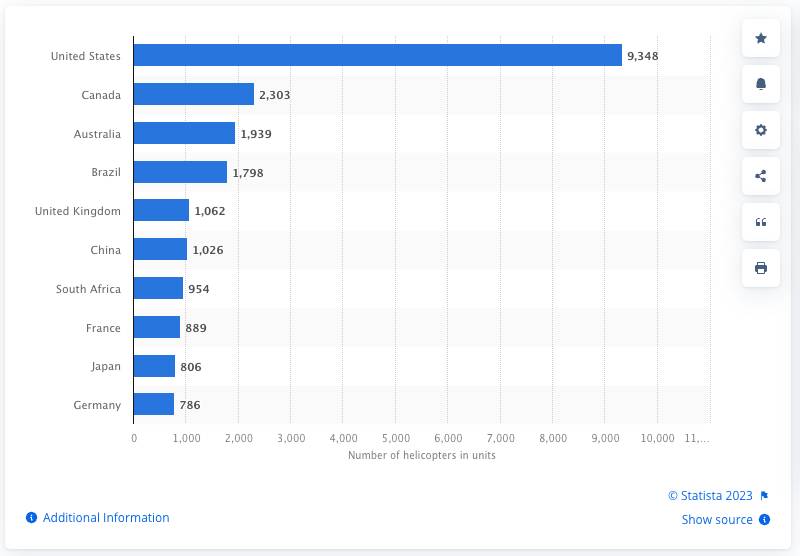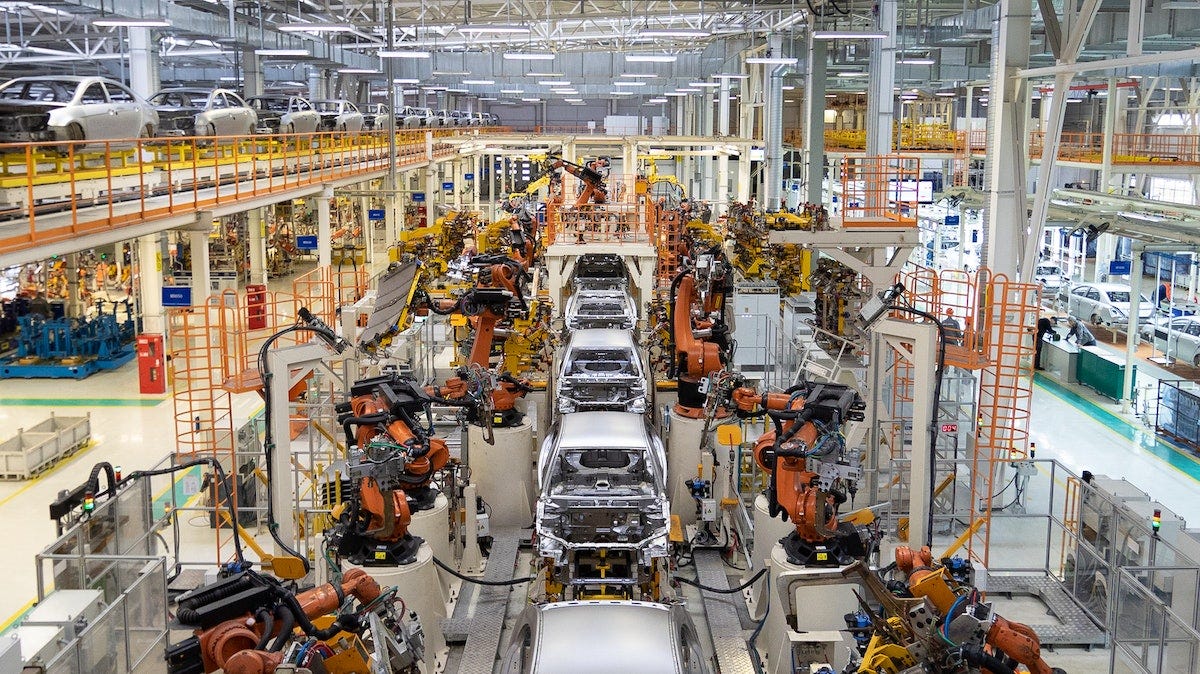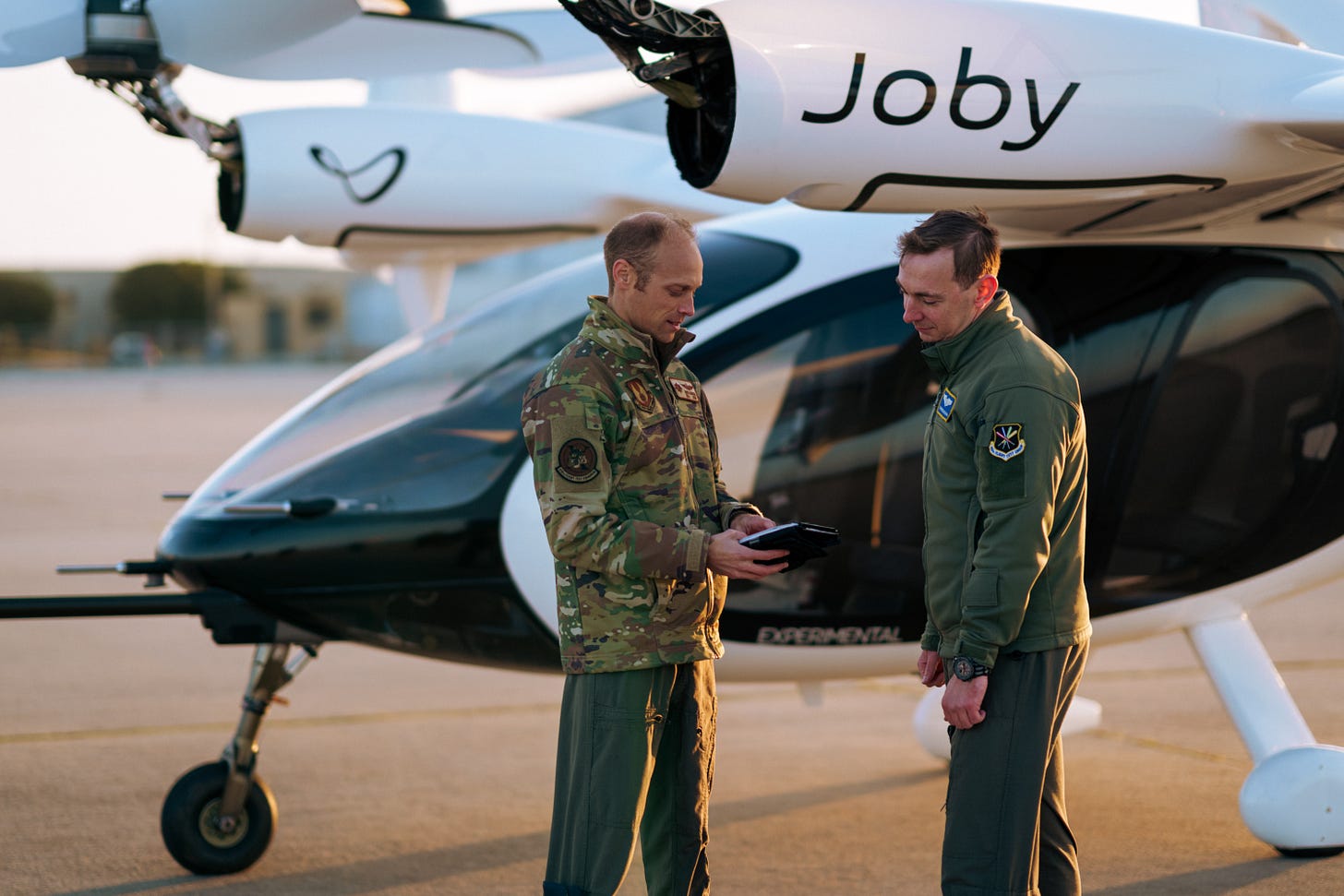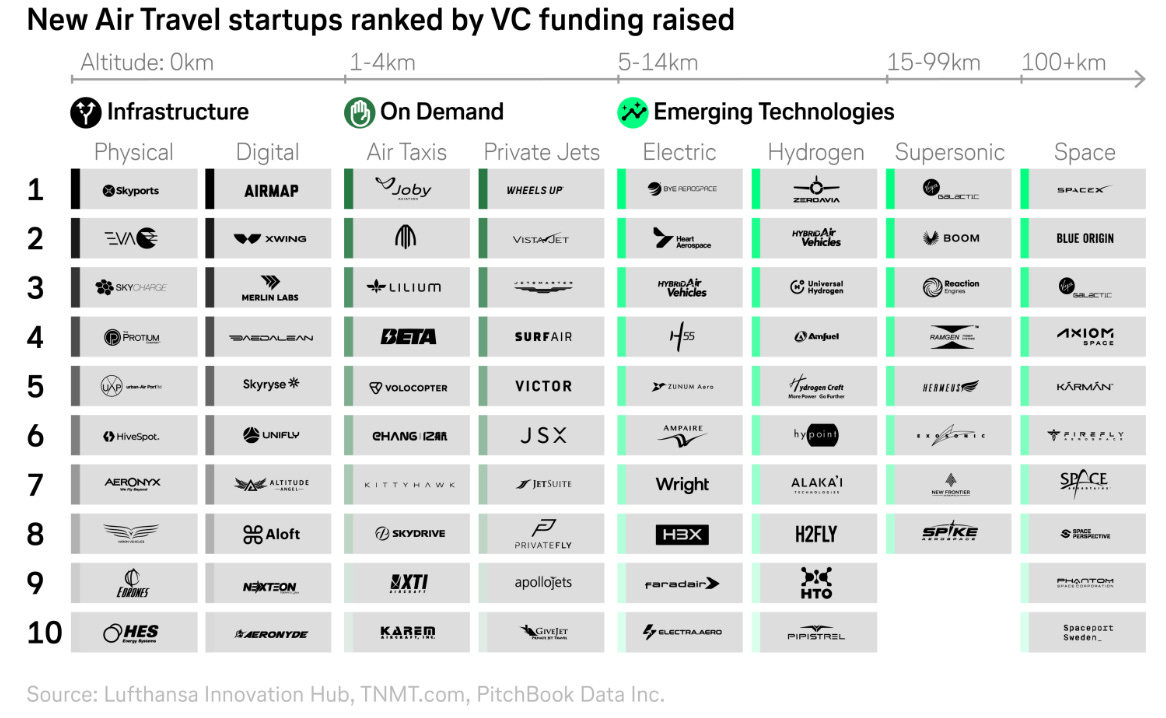Welcome to the 12 who have entered The Physicality since last week. If you aren’t subscribed, join the 417 others who care about the real world here:
“We wanted flying cars, instead we got 140 characters.”
– Peter Thiel, 2013
He of all people should have known that science fiction takes time. Ten years later, the future he sought is materializing before our eyes. Reusable rockets. Mass-produced electric cars. Drug factories in space. Humanoid robots. Robotic coffee shops. And we’re just getting started. Packy McCormick posits in Tech is Going to Get Much Bigger that “tech” will continue to encroach into “hard” industries like defense, energy, and transportation. By applying best practices from software, these new entrants will lap the old guard in years, not decades. It made me question where else we are seeing progress.
Enter: eVTOLs. These “Electric Vertical Take Off and Landing” vehicles are like helicopters, in that they can take off and land vertically. But unlike a helicopter, these electric vehicles are positioned to be lighter, safer, more dexterous, more sustainable, cheaper, and most importantly, far less noisy. Oh, and we will book them from our Uber app.
To learn about how eVTOLs would change us, I focused on the current leader in the category, Joby Aviation. Founded in 2009, Joby has grinded longer and racked up more test miles than anyone else. They plan to leverage that head start by launching their first commercial vehicles in 2025.
I need to tell you about them now because on November 13th, the day before publishing this piece, the first-ever Joby test flights flew from the Downtown Heliport in Manhattan. At the demo event with Mayor Adams and the NYC Economic Development Corporation, it was announced that this heliport will be the world’s first with eVTOL infrastructure. The future is here and you should know about it.
One of the first regular routes may be to LaGuardia Airport in Queens. Delta Airlines plans to use Joby to whisk passengers directly from “vertiports” throughout the city to as close to a Delta plane as possible. This would shrink an airport commute down to a fraction of the time it takes now.
Of course, there are already helicopter services like Blade that provide this. However, helicopters never reached scale and remain out of financial reach for most of us. Joby’s plan is to drive down the price of their air taxis as quickly as possible. They look to do this by leaning on key partnerships across the airline, automotive, and defense industries. If they succeed, more of us will travel short distances by air in our lifetimes.
There is a lot to unload, so let’s fly:
What in the Hel…icopter?
Joby Aviation
Launching Through Partnerships
A Rising Tide Lifts All eVTOLs
The Implications of Air Taxis on Our Lives
Let’s Ride in 2025
What in the Hel…icopter?
We have been obsessed with flight for ages. Big-brained Leonardo da Vinci designed a VTOL back in the 15th century. It took hundreds of years to turn this sketch into reality. What we know as a helicopter didn’t come about until the Sikorsky R-4 was manufactured for WW2.
You may be asking why eVTOLs are necessary when we already have helicopters. The short answer: Helicopters aren’t built for scale. Even after 80+ years, chopper travel never reached mass adoption. There are only 9000 helicopters in the United States and we mostly use them in the military, oil & gas, and medical industries.
The average commercial helicopter ride in 2023 is still wildly expensive. To get a sense of just how much, I laid out the costs for each option from Manhattan to LGA.
Assumptions:
Leaving the moment I wrote this at 10:17 am ET
Four passengers
Leaving from 30th St and 12th Ave, Blade’s West Lounge, a distance of 10.7 miles

It’s expensive to fly in a helicopter. Always has been. Probably always will be. I’ll explain shortly. Most of us will be born and die without stepping foot in one. I see the chopper as the CD-ROM or Segway. It was a great improvement to what came before, but only a stopover until we got to the real deal.
Joby Aviation
Joby’s “air taxis” are all electric. 100-mile range. Can travel at 200 miles per hour. Their first commercial vehicles will carry a pilot and four passengers for a total of 1000 lbs of payload per craft.
There are three key reasons why eVTOLs like Joby have a better chance of reaching mass adoption than their gas-powered predecessors: They’re silent-ish, safer, and cheaper.
Silent-ish
A major barrier to scaling helicopters is noise pollution. There are activist groups like Stop the Chop, “a grassroots organization formed to ban nonessential helicopter flights over the NY Metropolitan Area.” A major reason they provide is,
“Excessive helicopter traffic creates extreme noise which is believed to cause a large range of serious physical and mental health issues. It also can impair memory, lower reading, and speech comprehension, and reduce cognitive abilities in children and adults.”
Joby claims that their aircraft will be 100 times quieter than a helicopter and boasts a different noise profile. In a 2023 interview, CEO Joeben Bevrit revealed, “Instead of the ‘wap-wap’ of a helicopter that travels through the atmosphere and penetrates buildings, [Joby’s noise profile is] more of a white noise, like the wind in the trees.”
That was hard for me to believe until this recent NYC demo. One of the audience members asked why they couldn’t hear the Joby flying overhead. This lack of noise pollution is crucial to customer adoption and public acceptance. This single reason is why eVTOLs may make mass short-haul air travel a possibility in a way helicopters have not.
Safety
Helicopters have a single point of failure: one propeller. If that goes, you’re done. A key design feature of Joby’s vehicles is that they have six propellers. If 1-2 of the propellers break, energy is rerouted to the remaining ones and can still fly safely. Also, it has four batteries so if one fails, the other three can do more work. In time, regulators may consider eVTOLs safer than helicopters and encourage more to be made. In addition, customers who are hesitant to fly in a helicopter for safety reasons may be more open-minded to flying in a Joby.
Cheaper
Helicopters have always been expensive for many reasons but the two main ones are:
Low supply: As discussed above, there are only 9000 helicopters in the U.S. Airbus, which makes up 48% of the market, only made 300 in 2019. This means that there aren’t enough being produced to drive down the price. Such few vehicles keep the sticker price high.
High maintenance: Relating to safety, choppers create incredible vibrations to stay in the air. This means that its mechanisms are prone to moving out of place or breaking apart. The maintenance burden on helicopters is tremendous. They constantly need to be inspected and repaired.
Just like electric cars, electric VTOLs are magnitudes simpler than their gas counterparts. They require far fewer pieces and the propulsion system isn’t inherently trying to rip the vehicle apart. This reduces maintenance costs, which translates to cost-savings for us customers. If they are cheaper to maintain, then they are cheaper to fly. If they’re cheaper to fly, then more of us will use them. If more of us use them, then more will be made. If more are made, the cheaper they are. And so on. And that’s all without considering the sure-to-come improvements to battery technology. Now that you understand Joby’s potential, let’s look at how they plan on getting to market.
Launching Through Partnerships
Even with these perceived benefits, eVTOLs have an altitude to climb. Joby recognizes that federal and local regulation, public acceptance, and customer adoption are all massive barriers to entry. So, they intelligently cemented strategic partnerships across the mobility, airline, automotive, and defense industries that will make it easier for them on all these fronts. Each has a part to play in meeting their 2025 launch deadline.
Uber (Customer Adoption)
Imagine yourself walking out of the club. 3 am. Saturday night. You need to pee. You need McDonald’s. You whip open the Uber app. You order chicken nuggies to the crib. Then you look to order a car that will get you home in 30. That’s too long. You really need to go. Then you see a “fly home” option that takes 3 minutes. You click that. A car picks you up and evacs you to the nearest vertiport where a Joby is waiting. You’re home before your nuggets are.
This is a real possibility. Back in 2020, Joby acquired Uber Elevate, its air taxi division. According to the press release, “The two parent companies have agreed to integrate their respective services into each other’s apps, enabling seamless integration between ground and air travel for future customers. This deal allows Uber to accelerate the path to market.”
Instead of downloading a separate app, booking Joby will be done within the Uber App. This partnership gives Joby a first-class ticket to getting in front of Uber’s 110M U.S. users quickly.
Delta (Customer Adoption)
I’m getting ahead of myself. While this fantasy is ideal, the first route we likely get to book is from the city to the airport. In a SXSW interview, Joby revealed that their customers will be able to, “Stitch our air taxi flights seamlessly with your Delta flight. Integrating it into the [Delta] booking.” The idea is to be from air taxi to airplane in minutes, not hours.
Travel is stressful. We are prone to overspending for convenience. Just look at Clear, Amex Platinum, and semi-private airlines. Joby could become a part of that convenience suite. Knowing this would be the most reasonable go-to-market entry, Joby aligned itself with the #1 domestic airline.
This Delta partnership creates a consistent starting route for the company. Delta also invested billions in both its LGA and LAX presence. For these two reasons, they have immense sway with the Port Authority of New York and Los Angeles World Airports. These relationships are vital for a completely new form of commercial air travel to get off the ground.
Toyota
Toyota is considered the best manufacturer on Earth. So, it was a huge validator for Joby when they got into business together. Toyota became Joby’s largest external shareholder, their CEO joined the Joby board, they helped design their pilot production facilities, and more recently, cemented a long-term agreement to supply key components for Joby’s aircraft. Lending their manufacturing expertise on top of all of this will help Joby scale up to mass production in an intelligent way.
This agreement doubles as an early entrance into the Japanese market. A part of the partnership is to create an air taxi shuttle service for Toyota in Japan. Joby seems to be taking this seriously as they have applied to the Japan Civil Aviation Bureau (JCAB) and will be showing off their aircraft at the 2025 Osaka Expo.
Department of Defense
The final key partnership that makes Joby stand out from the fleet is with the Department of Defense. They have a $131M contract that consists of nine aircraft, the first of which was delivered in Q3 2023. These are the first eVTOLs used by the Air Force and will be used to “demonstrate a range of potential logistics use cases, including cargo and passenger transportation.”
In addition to dollars, a key benefit of this partnership is that the Air Force is training some of the first Joby pilots. This will inevitably help the company establish pilot standards with the FAA when the time comes. The Air Force isn’t the only military group that wants to fly the plane. The Army, Navy, and Marine Corps all expressed “active interest” in eVTOLs. I wonder what other ways a deadly quiet, safer, and lighter aircraft could be used by the U.S. armed forces.
It’s important to note that this partnership is not exclusive. Competitors like Archer also have secured similar agreements with the military.
Each of these partnerships is critical not only to Joby’s success but its entire peer group.
A Rising Tide Lifts All eVTOLs
Given all the hype around this new form of travel, Joby ($3.6B market cap) isn’t alone. The advanced air mobility category is hot. And it needs to be. Companies like Archer, Beta, and Lilium have all raised war chests from blue chip investors and also secured a myriad of key partnerships with airlines, automakers, the military, and technology giants. It’s a dogfight.
In Joby’s case, this is excellent news. Joby can’t reach critical mass on its own. In an unproven and difficult market like advanced air mobility, a rising tide provides significant lift. More competitors mean more vehicles in the air, customers flying, attention raised, capital deployed, and government action.
Joby seems ready to go. After building out of its pilot facility for years, it announced in September 2023 that they are opening a full-scale production facility in Dayton, Ohio. This plant is to build up to 500 aircraft per year. Their good friend Toyota will continue advising them on how to build this plant so it kicks major ass from day one.
However, it’s important to buttress my general optimism with the reality that both federal and local regulators take their time. Joby has nearly completed Stage Three of FAA’s Certification Process. There are two more stages to clear after that. Bradley Tusk, the political operative who helped Uber navigate the regulatory environment in NYC, cautions air taxi companies to be prepared for a war of attrition. In NYC, zoning and permitting are tough enough for bike lines and as he aptly puts it, “These are flying fucking cars.” Then comes public acceptance and customer adoption. However, I think most of you reading will jump out of a plane to get a chance to ride in an air taxi.
The Implications of Air Taxis on Our Lives
Say Joby pulls it off. Let’s sketch out the next 10 years. How will our urban landscape change? How will we change?
Expanding the Radius of Marchetti’s Constant
In the 70s, transportation engineer Yacov Zahavi concluded that people, in any culture or location, spend 1 to 1.5 hours commuting to work. 30 to 45 minutes each way. Physicist Cesare Marchetti expanded on Zahavi’s work in the 90s, determining that 1 hour is our commuting sweet spot, no matter the era or vehicle type. The key insight here is that even when our mode of transport is “faster,” we don’t travel less, we just travel f a r t h e r.
Our cities expand in line with how efficiently we can travel in, out, and throughout them in 30-minute distances. When our fastest mode of transport was walking, the walled Ancient Athens was 2km from East to West, ideal for a 30-minute walk. In comparison, Manhattan is 21.6 km long and 3.7 km wide. FRED stated that in 2021 the average New Yorker’s commute time was 32 minutes. The same as the olden days, even with all of our fancy subways, taxis, e-bikes, and scooters.
Of course, with cars came sprawl. The Census Bureau Reports that 1.6M workers commute into Manhattan each day. Now, think about eVTOLs that can travel 100 miles at a top speed of 200 mph. That means if you had access to a Joby, you could travel to Manhattan in half an hour from as far out as West Chester, PENNSYLVANIA — a route that takes 2.5 hours by car or 3.5 hours by train (not including the travel time to and from the stations).
The most obvious implication of eVTOLs is that we can regularly travel between long distances in a fraction of the time, expanding our Marchetti Constant by magnitudes.
Further Socioeconomic Divide?
Kevin DeGood, the Director of Infrastructure Policy at American Progress, concluded in his 2020 essay, “Flying Cars Will Undermine Democracy and the Environment,” that advanced air mobility will further divide us among socioeconomic lines.
“Flying cars threaten to magnify the corrosive effects—both sociopolitical and environmental—of sprawl and segregation by eliminating distance altogether. For the wealthy, the magnetic attraction to flying cars derives from their ability to connect in a few minutes the walled garden of home to the rich cultural amenities and economic opportunities of metropolitan life. In short, the high-speed transportation service that flying cars provide will help elites achieve a dual demand for hyperseclusion and hyperaccess.”
He argues that aircraft will be an extension of the wealthy’s penthouses, private cars, jets, and spaces they already hide behind. Helicopters are used this way already. While DeGood’s caution is warranted, it may not be necessary in this case.
What’s different here is that Joby is not trying to build private flying cars but instead, mass-used air taxis. Joby says they want to be affordable as quickly as possible. Oliver Walker-Jones, Head of Marketing, Communications & Brand at Joby states they plan on starting out with $5-7 per passenger mile, per passenger. This price point is similar to an Uber Black today. Once it can, it wants to settle its pricing down to $2-4, which is closer to a regular Uber. Of course, supply/demand and surge dynamics will be at play. Here is the chart from before, with Joby now included.

The Real World Will Change
Air taxis at scale will change the landscape of our cities. The most obvious is that there will be more landing points, in more places. Existing helipads won’t be enough. Roofs, stadiums, parking garages, parking lots, and piers may all accommodate the increased volume of air travel. Of course, these new pads will need charging infrastructure. This means that more real estate will need to plug into the grid.
I can imagine that major hubs will build entire air taxi stations. Large ones like Penn Station and small ones like the New York City ferry.
A key difference is that air taxis take off quickly. As opposed to Penn Station, where people could be waiting for 30-60 minutes for a train, the idea is that you’re hardly waiting at all. Quick commerce will have to service this new transportation type. Convenience stores (Wawa?), fast food (In-N-Out?), and micro-coffee shops (Blank Street?) will pop up in and around these landing pads.
Let’s Ride in 2025
I await Joby’s launch with bated breath. I have my eyes wide open about how long it’s taken (~15 years) for Joby to get to this point. I acknowledge that regulators control much of the outcome. I am aware of how other hyped-up and heavily capitalized real-world industries like autonomous trucking and broader self-driving have missed one deadline after the next. But it feels like we are entering a golden age of “hard” technological innovation. With the extremely recent Joby test flights in New York City, this golden age is landing in my backyard.
Science fiction usually includes a timeframe as part of its setting. For example, Star Trek is set in the 2100s. Authors draw a dotted line in the sand of how much collective progress we make by that point. It feels as if more science fiction is becoming plain science with each passing day. We anticipate progress as a given. But it’s not. It is efforts like Joby's that become a part of that great journey from futuristic to factual. When we get to fly in an electric air taxi in 2025, get in, human progress literally is flying overhead.
Keep it Real,
Safi
Thank you to Julianna, Kaley, and Jack for editing!
What’s Next?
Like what you read? Please like and leave a comment. It really helps!
Share this with someone who you want to fly in an air taxi with
If you’re a company that is interested in a Sponsored Deep Dive or sponsoring the next issue, drop me an email. Check out the deep dives on Kindred or Stuga to get a feel for what we do around here.

























